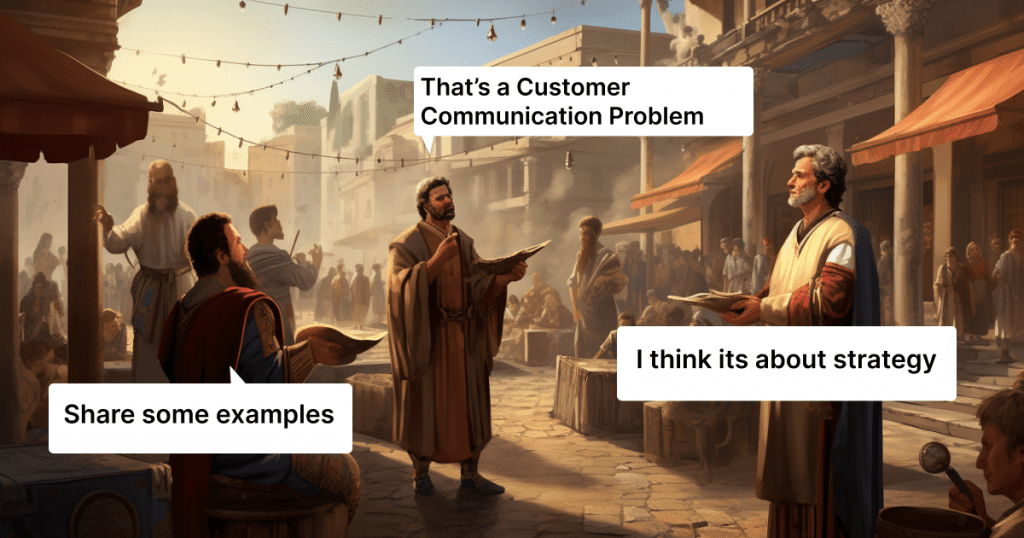If you’re looking for a comprehensive resource, this customer communication guide is designed to help you build trust, enhance experiences, and foster loyalty. Customer communication strategy isn’t just about answering questions—it’s about effective customer support, building trust, enhancing the customer experience, and boosting Brand allegiance
This guide will show you how a strong customer communication strategy can transform how your business interacts with customers. You’ll learn the best practices, see real-world examples, and discover how tools like customer communications platforms can help. Whether you’re part of a customer service team, a marketer, or an e-commerce owner, there’s something here for everyone.
We’ll cover:
- What customer communication style refers to and why it matters
- The top customer communication strategies to implement today
- Examples of effective communication across multiple channels
- Tips for maintaining Steady messaging while meeting customer expectations
By the end, you’ll have actionable tips to create an effective customer communications strategy that improves customer interactions, enhances brand reputation, and drives business success.
What is Customer Communication and Why is It Important?
Customer communication refers to how a business interacts with its customers across various communication channels. This can include anything from answering customer inquiries via phone calls to sending Social updates, providing top-notch customer support or delivering personalized marketing messages. Every customer communication plays a part in shaping the overall customer experience.
But why is a customer communication strategy important? The way you communicate impacts:
- Customer Satisfaction: Consumers sense valued when their needs and concerns are addressed promptly and thoughtfully.
- Customer Loyalty: Positive interactions build trust and strong customer relationship management, making it easier to retain customers.
- Brand Reputation: Clear and Uniform interaction reinforces your brand’s identity and fosters credibility.
- Business Growth: Satisfied and loyal customers are more likely to recommend your business, contributing to long-term success.
Key Benefits of Effective Customer Communication
- Proactive communication: Anticipating and addressing customer concerns before they escalate.
- Better customer retention: Strengthening connections by making Buyers experience heard and appreciated.
- Improved customer engagement: Using data and multiple channels to meet customers’ preferences.
Without a strong customer communication strategy, businesses risk mismanaging User requirements, leading to frustration and missed opportunities to build positive customer experiences. Forward-thinking engagement helps build trust with both existing and potential customers by addressing concerns upfront. Whether you’re relying on self-service options or in-person communication, the goal should always be to ensure that Clients perceive supported at every stage of their customer journey.
Best Practices for Effective Customer Communication
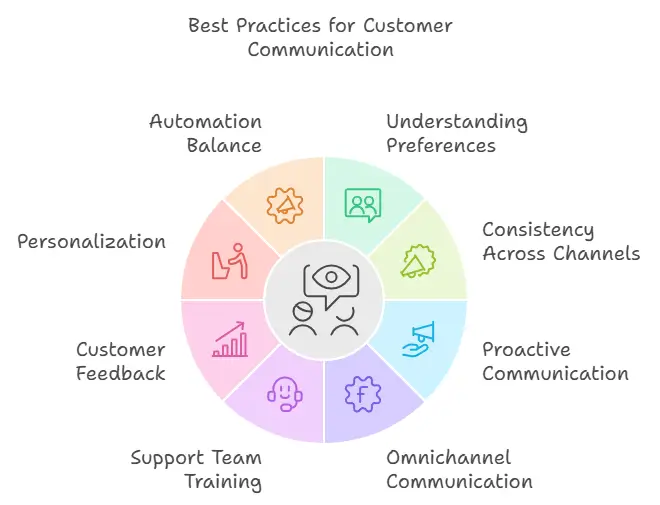
A Solid communication framework doesn’t happen by chance—it’s built on thoughtful planning and consistent execution. Below are the best practices to elevate your customer Contact measures and foster positive customer experiences.
1. Understand Your Customer’s Preferences
Every customer is different, so knowing their communication preferences is key. Some may prefer live chat or social media, while others might rely on phone calls or email. Use customer data to tailor your approach to their needs and ensure Users react heard.
2. Maintain Consistency Across Channels
When customers interact with your brand on multiple channels, such as your website, social media, or a knowledge base, the tone and message should feel seamless. Consistent brand messaging not only enhances your brand reputation but also helps customers trust your communication.
3. Use Proactive Communication
Don’t wait for customers to raise issues. Be proactive by anticipating customer concerns. For example, notify them about order delays or share updates on your latest offerings. Preemptive outreach shows you value their time and builds goodwill.
4. Leverage Omnichannel Communication
With today’s tools, it’s easier than ever to meet customers where they are. Invest in customer communication platforms that integrate live chat, email, social, and more. Omnichannel approaches allow your Client support group to seamlessly manage interactions across all touchpoints.
5. Train Your Support Team for Success
Your Client support groups are the frontline of your business. Ensure they’re trained to handle both complex issues and everyday queries with professionalism. Equip them with resources like an automated knowledge base to respond to customers quickly and accurately.
6. Actively Collect and Use Customer Feedback
Feedback is one of the most valuable tools for improving your communication strategies. Use surveys, reviews, and one-on-one interactions to gain valuable insights into what your customers want. Then, adjust your approach to better align with their needs.
7. Personalize Your Communication
Generic messages can alienate customers. Personalization, on the other hand, shows customers that you’re paying attention. Use customer data to craft messages that feel tailored to them, whether through a personalized email or a thoughtful response to a customer request.
8. Balance Automation with Human Interaction
Automation, like automated knowledge base responses, is great for quick answers to common queries. However, customers still value the human touch for Multifaceted situations or when they’re feeling frustrated. Strike a balance to offer efficiency without losing the personal connection.
Examples of Best Practices in Action
- E-commerce Business: Sending a follow-up email after a purchase with personalized recommendations based on previous orders.
- Small Business Owner: Proactively informing customers of new store hours or promotions via text or email.
- Customer Support Team: Using a live chat tool to reduce response times while maintaining a friendly tone.
These practices help improve overall customer satisfaction, strengthen customer relationships, and ensure that your communication strategy aligns with your business serves goals.
Tools and Technologies for Customer Communication
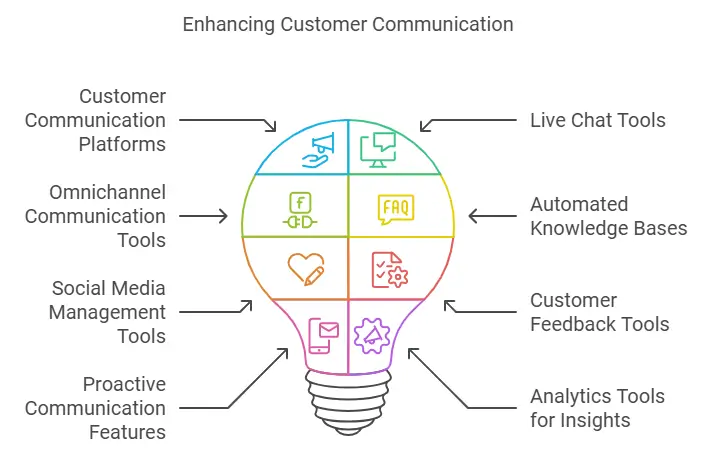
To implement an effective customer communication strategy, the right tools can make all the difference. These platforms and technologies streamline customer communication efforts, enhance team productivity, and ensure Patrons encounter supported.
1. Customer Communication Platforms
These platforms centralize all your communication channels, making it easy to track and respond to customer interactions. Popular options include:
- Zendesk: Ideal for Service representatives managing high volumes of queries.
- HubSpot: Combines communication with customer relationship management (CRM) tools.
- Intercom: Great for live chat and in-app messaging.
2. Live Chat Tools
Real-time communication is essential for addressing customer inquiries quickly. Tools like LiveChat and Tawk.to allow businesses to respond in real-time, improving customer satisfaction and creating a positive customer experience.
3. Omnichannel Communication Tools
For a seamless customer journey, omnichannel tools integrate multiple channels into a single system. Options like Freshdesk Omnichannel ensure consistent responses across email, chat, social media, and more.
4. Automated Knowledge Bases
An automated knowledge base offers 24/7 support with self-help options. Tools like HelpDocs and Zoho Desk let businesses provide instant answers to common queries, reducing the load on the support team while increasing overall customer satisfaction.
5. Social Media Management Tools
Social media is a key part of customer communication channels today. Platforms like Hootsuite and Buffer allow you to schedule social media posts, track customer comments, and respond quickly to queries.
6. Customer Feedback Tools
Actively collecting feedback is vital for improving communication. Tools like SurveyMonkey and Qualtrics let you gather insights on customer behavior, customer needs, and areas for improvement.
7. Proactive Communication Features
- Email Automation Tools: Platforms like Mailchimp help send timely updates or personalized offers based on customer data.
- Push Notification Tools: Services like OneSignal deliver important updates to customers via apps or browsers.
8. Analytics Tools for Insights
Understanding key customer communication metrics helps refine your strategies. Tools like Google Analytics and Mixpanel track customer engagement, providing valuable insights into Consumer demands and preferences.
Why These Tools Matter
Using these technologies ensures you can:
- Communicate with your customers on Different touchpoints effectively.
- Meet customers’ preferences with personalized interactions.
- Gain a better understanding of customer sentiment through analytics.
- Automate repetitive tasks, freeing up your team for Difficult cases.
The right mix of tools enhances both the customer and business side of communication, making it easier to retain customers and improve customer retention.
Real-World Examples of Customer Communication in Action
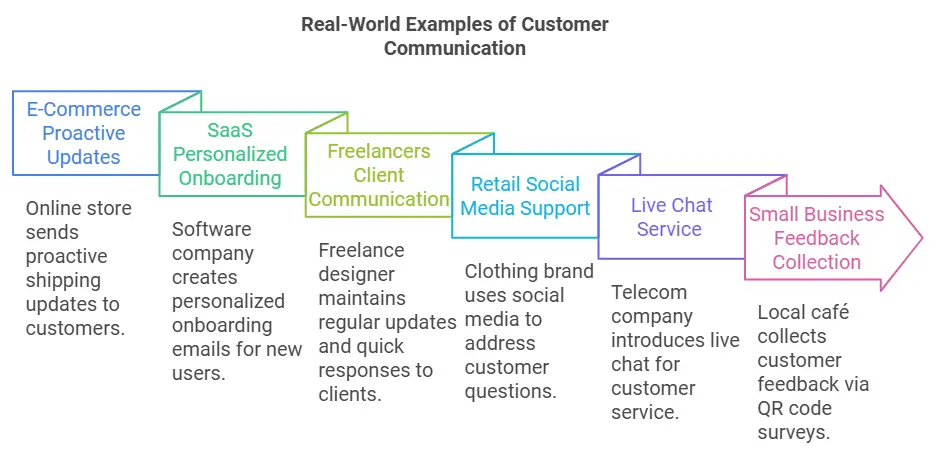
Learning from real-world examples helps put theory into practice. Below are examples of businesses using effective customer interaction strategies to engage customers, resolve issues, and boost customer satisfaction.
1. E-Commerce Business: Proactive Shipping Updates
An online store faced delays due to supply chain issues. Instead of waiting for customer inquiries, they sent out Anticipatory messaging to inform buyers of the delays via email and text. The messages included:
- Estimated delivery times.
- Apologies for the inconvenience.
- Discount codes for future purchases as goodwill gestures.
Result: Customers appreciated the transparency, leading to fewer complaints and stronger Consumer devotion.
2. SaaS Company: Personalized Onboarding Emails
A software company used customer data to create personalized onboarding journeys for new users. They sent:
- Step-by-step guides tailored to the user’s selected features.
- Links to relevant knowledge base articles.
- Contact options for their support team in case of questions.
Result: Enhanced customer engagement, reduced churn, and improved adoption rates for their software.
3. Freelancers: Building Strong Client Relationships
A freelance graphic designer ensured Steady messaging with clients through:
- Weekly updates on project progress.
- Quick responses to customer requests via email or chat.
- Offering self-service scheduling tools for feedback meetings.
Result: Clients felt involved and valued, leading to repeat projects and referrals.
4. Retail Store: Leveraging Social Media for Support
A clothing brand used social media posts to address common customer questions. They responded to comments and DMs within minutes using a customer communication platform. Additionally, they shared videos showing how to use their products effectively.
Result: Increased customer satisfaction and engagement, with more customers feeling supported in their buying decisions.
5. Customer Service Teams: Live Chat for Complicated matters
A telecom company’s customer service team introduced live chat to handle billing inquiries and technical issues. For Complicated matters, they connected customers to trained specialists while keeping wait times minimal.
Result: Faster issue resolution, improved Client feedback, and a boost in Comprehensive customer approval.
6. Small Business: Collecting and Acting on Feedback
A local café asked customers to complete a quick survey via a QR code on receipts. Feedback revealed preferences for healthier menu options. The café responded by adding new dishes and emailing customers about the updates.
Result: Stronger Client connections and higher Customer holding.
Key Takeaways from These Examples
- Transparency builds trust: Keep customers informed, even about setbacks.
- Personalization matters: Tailored communication shows customers they’re valued.
- Omnichannel strategies enhance convenience: Let Clients communicate on their terms.
- Feedback drives improvement: Listening and acting on feedback fosters loyalty.
With these examples in mind, businesses can fine-tune their customer communication efforts to match their audience’s needs and expectations.
Key Metrics to Measure Success in Customer Communication
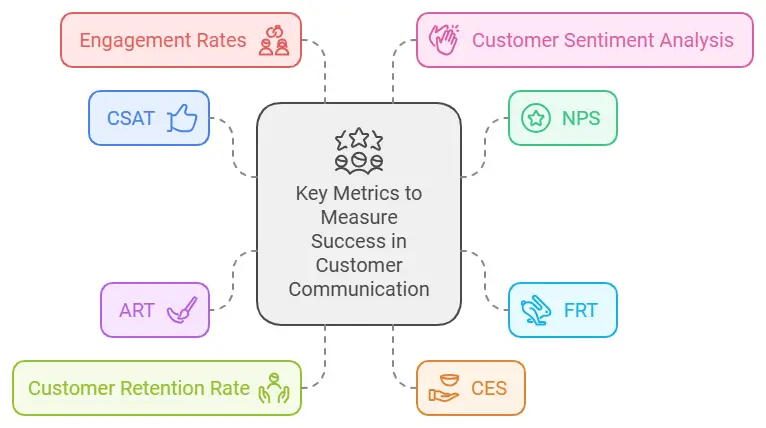
Tracking the right metrics is essential for evaluating your customer Messaging initiatives. These metrics provide actionable insights into your strategy’s effectiveness and help identify areas for improvement. Below are the key metrics every business should monitor.
1. Customer Satisfaction Score (CSAT)
CSAT measures how satisfied customers are with a specific interaction, product, or service. Typically, customers rate their satisfaction on a scale (e.g., 1–5).
- Why it matters: High CSAT scores indicate successful communication and resolution of customer concerns.
- How to improve: Provide clear and empathetic responses to queries and ensure consistent communication across Numerous mediums
2. Net Promoter Score (NPS)
This metric evaluates how likely customers are to recommend your business to others on a scale of 0–10.
- Why it matters: NPS reflects overall Client retention and their perception of your brand’s communication style.
- How to improve: Build trust through personalized interactions and proactive updates.
3. First Response Time (FRT)
FRT tracks the time it takes for your team to respond to a customer query. Faster responses often lead to happier customers.
- Why it matters: Quick responses make Buyers experience prioritized, leading to better customer retention.
- How to improve: Use tools like live chat and automating communication for common queries.
4. Average Resolution Time (ART)
This measures the average time it takes to resolve customer issues, from initial contact to final resolution.
- Why it matters: A lower resolution time enhances General client contentment by showing efficiency in addressing customer requests.
- How to improve: Equip your Helpdesk staff with resources like an automated knowledge base to solve issues faster.
5. Customer Retention Rate
This metric shows how many customers continue to do business with you over time. Retention is a strong indicator of effective communication and engagement.
- Why it matters: Retaining customers is more cost-effective than acquiring new ones.
- How to improve: Maintain a Comprehensive Consumer connection approach to address needs and exceed Client needs
6. Customer Effort Score (CES)
CES measures how easy it is for customers to get help or complete a task (e.g., resolving an issue or finding information).
- Why it matters: A lower effort score means customers find your communication channels simple and convenient.
- How to improve: Offer self-help options like an FAQ section or self-service tools.
7. Engagement Rates
Engagement rates track how customers engage with your Promotional content, such as email open rates or social media comment responses.
- Why it matters: High engagement reflects strong connections with your audience.
- How to improve: Ensure consistent brand messaging and personalize content to align with customers’ preferences.
8. Customer Sentiment Analysis
This involves analyzing the tone of customer feedback to determine whether interactions are positive, negative, or neutral.
- Why it matters: Understanding sentiment helps businesses address underlying issues and improve customer communication management.
- How to improve: Monitor feedback across channels and use it to refine your communication strategy.
Using Metrics for Business Growth
Tracking these metrics allows businesses to identify strengths and weaknesses in their Messaging initiatives. By improving performance in these areas, you can:
- Increase customer satisfaction.
- Enhance Repeat business.
- Drive long-term Economic progress.
Common Challenges in Customer Communication and How to Overcome Them
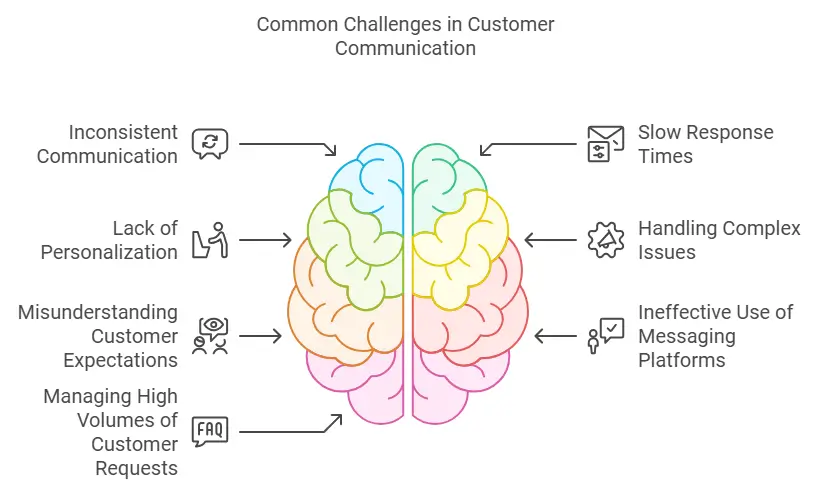
Even with a solid customer communication strategy, businesses can face obstacles that disrupt their customer interactions. Recognizing and addressing these challenges is crucial to delivering a positive customer experience.
1. Inconsistent Communication Across Channels
The Problem: When customers interact through Diverse outlets (email, chat, phone, or social media), inconsistent responses or mismatched tone can create confusion.
How to Overcome It:
- Use omnichannel communication tools to unify all channels into one system.
- Train your Customer assistance teams to follow the same guidelines for tone, accuracy, and professionalism across platforms.
- Develop clear communication strategies to maintain consistent brand messaging.
2. Slow Response Times
The Problem: Customers expect quick replies, but delays can lead to dissatisfaction and loss of customer loyalty.
How to Overcome It:
- Set up automating communication for simple queries using chatbots or pre-written responses.
- Monitor key customer communication metrics, like First Response Time, to identify delays.
- Equip your Helpdesk staff with resources like a robust Help center to improve efficiency.
3. Lack of Personalization
The Problem: Generic responses make customers feel heard, reducing engagement and trust.
How to Overcome It:
- Collect and analyze customer data to understand customers’ preferences and behaviors.
- Use tools that allow for personalized emails, recommendations, and responses tailored to individual needs.
4. Handling Complex Issues
The Problem: Automated systems may struggle with Difficult cases that require a human touch.
How to Overcome It:
- Train your team to recognize when to escalate issues to a live representative.
- Provide advanced training on problem-solving and customer empathy for customer service teams.
- Ensure easy access to human support when automation falls short.
5. Misunderstanding Customer Expectations
The Problem: Failing to meet customer expectations can result in dissatisfaction or negative feedback.
How to Overcome It:
- Collect customer feedback regularly to gain insights into their needs and pain points.
- Monitor customer behavior across channels to predict what they want.
- Be transparent about what your business can deliver, avoiding overpromises.
6. Ineffective Use of Messaging platforms
The Problem: Businesses sometimes over-rely on certain channels, leaving others underutilized.
How to Overcome It:
- Understand which customer communication channels your audience prefers.
- Experiment with a mix of social media, live chat, email, and in-person options to find what works best.
- Adjust your approach based on channel performance data.
7. Managing High Volumes of Customer Requests
The Problem: During peak times, overwhelmed teams may struggle to handle the surge in customer inquiries.
How to Overcome It:
- Use self-service tools like automated knowledge base responses to handle common questions.
- Scale your Technical help team during high-demand periods with temporary staff or flexible shifts.
- Leverage AI to prioritize and route urgent requests to the right agents.
Key Takeaways for Overcoming Communication Challenges
- Invest in tools that improve efficiency without sacrificing quality.
- Focus on Strategic updates to prevent problems before they arise.
- Regularly review and refine your customer communication management processes.
Addressing these challenges ensures that your customer communication strategy evolves with customer needs, leading to stronger relationships and greater business success.
FAQs
1. What is customer communication, and why is it important?
Client interaction involves to all the ways a business interacts with its customers, from phone calls and emails to social media posts and chat. It’s important because effective communication builds trust, enhances customer satisfaction, and drives loyalty.
2. What are the best communication channels for businesses?
The best channels depend on your audience’s preferences. Popular options include:
Live chat for instant support.
Social media for engagement and quick updates.
Email for personalized marketing messages.
Self-service options like FAQs or a Information hub for convenience.
3. How can businesses improve their communication strategy?
Understand customer needs and preferences.
Use tools like customer communication platforms for better organization.
Train your team to handle both simple and complex issues.
Monitor key metrics like response time and feedback scores.
4. What tools can help manage customer communication?
Some effective tools include:
Zendesk and HubSpot for centralized communication and CRM.
LiveChat for real-time support.
Hootsuite for managing social media interactions.
5. How does personalization improve customer communication?
Personalization shows customers that you value their unique needs. It can be as simple as addressing them by name or as detailed as tailoring recommendations based on customer data. This approach fosters deeper connections and builds strong customer relationships.
Conclusion: Elevate Your Customer Communication Strategy
Great customer communication isn’t just about solving problems—it’s about building trust, nurturing relationships, and driving Operational excellence. Whether you’re engaging with a first-time buyer or a loyal customer, every interaction shapes how customers feel about your brand.
By implementing a Effective customer engagement strategy, you can:
- Improve customer satisfaction and create a positive customer experience.
- Foster customer loyalty by addressing concerns and exceeding expectations.
- Enhance your brand reputation through Reliable dialogue and transparency.
Use the insights, tools, and strategies shared in this guide to fine-tune your approach. Focus on proactive engagement, personalization, and seamless service across Various platforms. When customers feel valued and valued, they’ll keep coming back—and even recommend your business to others.
